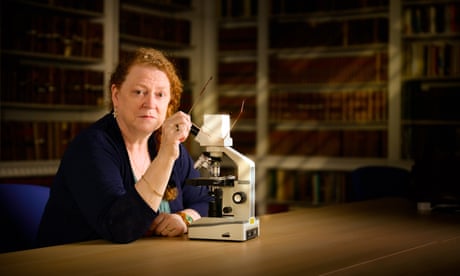F rom a solitary set of finger bones to a fragment of skull in a washing machine, the cases Dame Sue Black has helped solve may seem too gruesome for the joyful spectacle that is the Royal Institution Christmas lectures. But it is not the stuff of nightmares that Black, one of the world’s leading forensic anthropologists, will be exploring as she gives Britain’s most prestigious public science lectures this winter. Instead she will be investigating the myriad ways in which our bodies are tied to our identity.
“Where we translate it, [our work] can become gruesome but what we actually do is fascinating to everybody, because you’re really just talking about yourself,” she said. A prime example is Black’s work on how the creases, veins, freckles and other features on our hands can be used to tell us apart. “We can get everybody looking at their hands, looking at their vein patterns, understanding why they’re different on your right and your left side, why they’re different from your identical twin – which makes it really different to DNA,” said Black.
“All of those things become very personable, and the kinds of things that you can talk about, believe it or not, across the breakfast table. ” The application is, however, rather darker. Black pioneered the approach in response to a case involving a teenage girl who said she was sexually abused by her father.
The girl had captured video footage, but investigators had little to go on except for images of the perpetrator’s hands. A professor of anatomy, and now president of Oxford’s St John’s College, Black’s work ranges from the earthy – including going digging for bodies – to the existential, questioning what makes us who we are, and how others can identify us. These questions are what Black hopes to explore with audiences in the Christmas lectures, with input from lawyers, detectives, pathologists and even dog handlers.
“We want to be able to get across is the human body is really just layers upon layers of memory, and memories that have been laid down over time,” she said. Indeed while our DNA is rooted in our ancestry, other features – like our fingerprints – are shaped not just by genetics but the environment, and developmental processes, we experience in the womb . Life experiences can also leave their mark: in one case Black used clues within the rib cartilage of a body found in woodland to reveal the person may have been transgender , while the stable isotope composition of hair can, through its link to diet, indicate that someone has moved from one part of the country to another.
An expert in putting names to corpses, Black has been involved in myriad cases, from the “Limbs in the Loch” murder, to identifying those killed in the 2004 tsunami – so it is little surprise crime writers including Val McDermid have sought her advice. Black’s life has also contained darkness: she has previously disclosed she was raped as a child. Yet she is clear that was not what drove her to pursue a career in forensics.
Rather, she says, her fascination with anatomy was natural after a childhood spent skinning rabbits and plucking pheasants shot by her beloved father, with forensics offering a way to relate anatomy to the wider world. Understanding what is, and what is not, human, said Black, is crucial. “The last thing you want to do is set a murder investigation going and it turns out to be a bit of spare rib from a local takeaway,” she said.
Black says she copes with the harrowing aspect of her work by closing a psychological door on her work at the end of the day. The last thing you want to do is set a murder investigation going and it turns out to be a bit of a takeaway spare rib Sue Black “The big fear, of course, and it’s a fear for everybody in this field, is that that door sometimes just doesn’t shut completely,” she said. One case that has stayed with her is that of a man in Kosovo who lost 11 members of his family, including eight children, to rocket-propelled grenades.
“He was looking for 11 body bags back each with a bit of a named family member in it,” said Black. Such experiences have clearly left their mark. “Being in disaster victim identification, [you know] there is always the possibility that something is going to happen, always,” she said.
As a result, Black has “body-mapped” her daughters, making notes of birth marks and taking fingerprints, toe-prints and blood samples. She also discouraged them from having braces as children. “Part of what’s identifiable about you is the crookedness of your teeth,” she says.
“I’d much rather that your mouth look like a robbed graveyard than it look like Tom Cruise. ” Black says she is not concerned that would-be criminals might learn some tricks of the trade from the lectures. Rather, she hopes to send a message.
“Most criminals, God bless them, are not very smart, which is why they get caught … they don’t think it applies to them,” says Black. “But,” she adds, “they also need to know that science is on their tail. ” The Christmas lectures from the Royal Institution will be broadcast on BBC Four between Christmas and the new year.
The ticket ballot for the live filming opens to Royal Institution members and young members on Monday 26 September. .
From: theguardian
URL: https://www.theguardian.com/science/2022/sep/23/forensic-anthropologist-dame-sue-black-royal-institution-christmas-lectures
